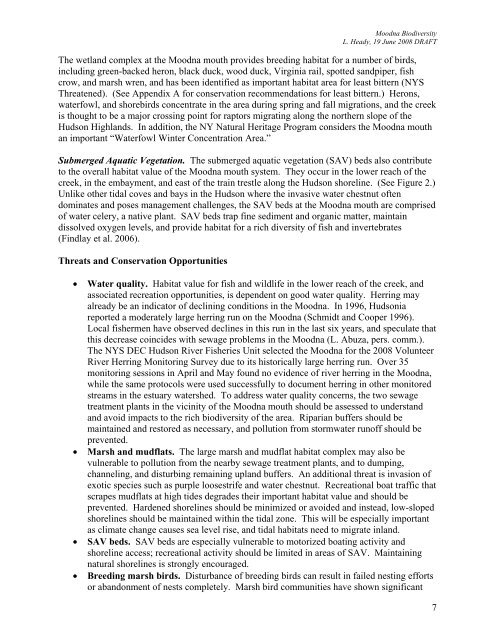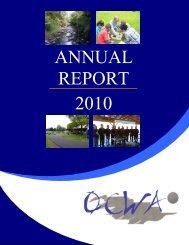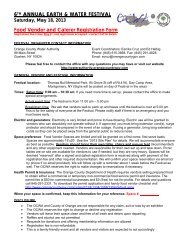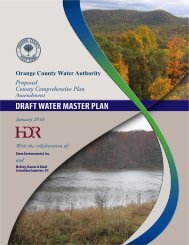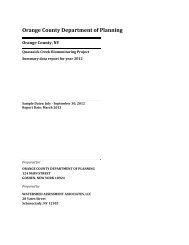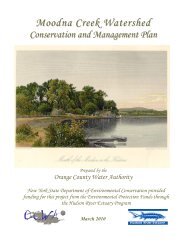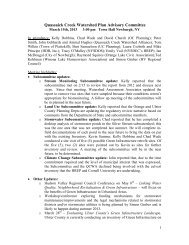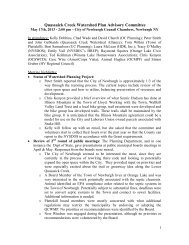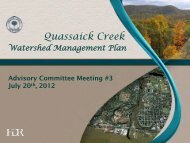Biodiversity of the Moodna Creek Watershed - Orange County Water ...
Biodiversity of the Moodna Creek Watershed - Orange County Water ...
Biodiversity of the Moodna Creek Watershed - Orange County Water ...
Create successful ePaper yourself
Turn your PDF publications into a flip-book with our unique Google optimized e-Paper software.
<strong>Moodna</strong> <strong>Biodiversity</strong><br />
L. Heady, 19 June 2008 DRAFT<br />
The wetland complex at <strong>the</strong> <strong>Moodna</strong> mouth provides breeding habitat for a number <strong>of</strong> birds,<br />
including green-backed heron, black duck, wood duck, Virginia rail, spotted sandpiper, fish<br />
crow, and marsh wren, and has been identified as important habitat area for least bittern (NYS<br />
Threatened). (See Appendix A for conservation recommendations for least bittern.) Herons,<br />
waterfowl, and shorebirds concentrate in <strong>the</strong> area during spring and fall migrations, and <strong>the</strong> creek<br />
is thought to be a major crossing point for raptors migrating along <strong>the</strong> nor<strong>the</strong>rn slope <strong>of</strong> <strong>the</strong><br />
Hudson Highlands. In addition, <strong>the</strong> NY Natural Heritage Program considers <strong>the</strong> <strong>Moodna</strong> mouth<br />
an important “<strong>Water</strong>fowl Winter Concentration Area.”<br />
Submerged Aquatic Vegetation. The submerged aquatic vegetation (SAV) beds also contribute<br />
to <strong>the</strong> overall habitat value <strong>of</strong> <strong>the</strong> <strong>Moodna</strong> mouth system. They occur in <strong>the</strong> lower reach <strong>of</strong> <strong>the</strong><br />
creek, in <strong>the</strong> embayment, and east <strong>of</strong> <strong>the</strong> train trestle along <strong>the</strong> Hudson shoreline. (See Figure 2.)<br />
Unlike o<strong>the</strong>r tidal coves and bays in <strong>the</strong> Hudson where <strong>the</strong> invasive water chestnut <strong>of</strong>ten<br />
dominates and poses management challenges, <strong>the</strong> SAV beds at <strong>the</strong> <strong>Moodna</strong> mouth are comprised<br />
<strong>of</strong> water celery, a native plant. SAV beds trap fine sediment and organic matter, maintain<br />
dissolved oxygen levels, and provide habitat for a rich diversity <strong>of</strong> fish and invertebrates<br />
(Findlay et al. 2006).<br />
Threats and Conservation Opportunities<br />
• <strong>Water</strong> quality. Habitat value for fish and wildlife in <strong>the</strong> lower reach <strong>of</strong> <strong>the</strong> creek, and<br />
associated recreation opportunities, is dependent on good water quality. Herring may<br />
already be an indicator <strong>of</strong> declining conditions in <strong>the</strong> <strong>Moodna</strong>. In 1996, Hudsonia<br />
reported a moderately large herring run on <strong>the</strong> <strong>Moodna</strong> (Schmidt and Cooper 1996).<br />
Local fishermen have observed declines in this run in <strong>the</strong> last six years, and speculate that<br />
this decrease coincides with sewage problems in <strong>the</strong> <strong>Moodna</strong> (L. Abuza, pers. comm.).<br />
The NYS DEC Hudson River Fisheries Unit selected <strong>the</strong> <strong>Moodna</strong> for <strong>the</strong> 2008 Volunteer<br />
River Herring Monitoring Survey due to its historically large herring run. Over 35<br />
monitoring sessions in April and May found no evidence <strong>of</strong> river herring in <strong>the</strong> <strong>Moodna</strong>,<br />
while <strong>the</strong> same protocols were used successfully to document herring in o<strong>the</strong>r monitored<br />
streams in <strong>the</strong> estuary watershed. To address water quality concerns, <strong>the</strong> two sewage<br />
treatment plants in <strong>the</strong> vicinity <strong>of</strong> <strong>the</strong> <strong>Moodna</strong> mouth should be assessed to understand<br />
and avoid impacts to <strong>the</strong> rich biodiversity <strong>of</strong> <strong>the</strong> area. Riparian buffers should be<br />
maintained and restored as necessary, and pollution from stormwater run<strong>of</strong>f should be<br />
prevented.<br />
• Marsh and mudflats. The large marsh and mudflat habitat complex may also be<br />
vulnerable to pollution from <strong>the</strong> nearby sewage treatment plants, and to dumping,<br />
channeling, and disturbing remaining upland buffers. An additional threat is invasion <strong>of</strong><br />
exotic species such as purple loosestrife and water chestnut. Recreational boat traffic that<br />
scrapes mudflats at high tides degrades <strong>the</strong>ir important habitat value and should be<br />
prevented. Hardened shorelines should be minimized or avoided and instead, low-sloped<br />
shorelines should be maintained within <strong>the</strong> tidal zone. This will be especially important<br />
as climate change causes sea level rise, and tidal habitats need to migrate inland.<br />
• SAV beds. SAV beds are especially vulnerable to motorized boating activity and<br />
shoreline access; recreational activity should be limited in areas <strong>of</strong> SAV. Maintaining<br />
natural shorelines is strongly encouraged.<br />
• Breeding marsh birds. Disturbance <strong>of</strong> breeding birds can result in failed nesting efforts<br />
or abandonment <strong>of</strong> nests completely. Marsh bird communities have shown significant<br />
7


